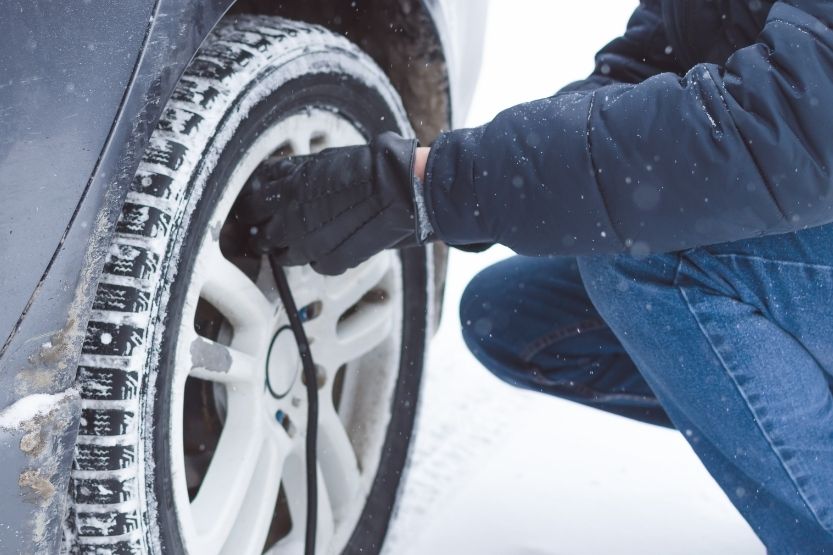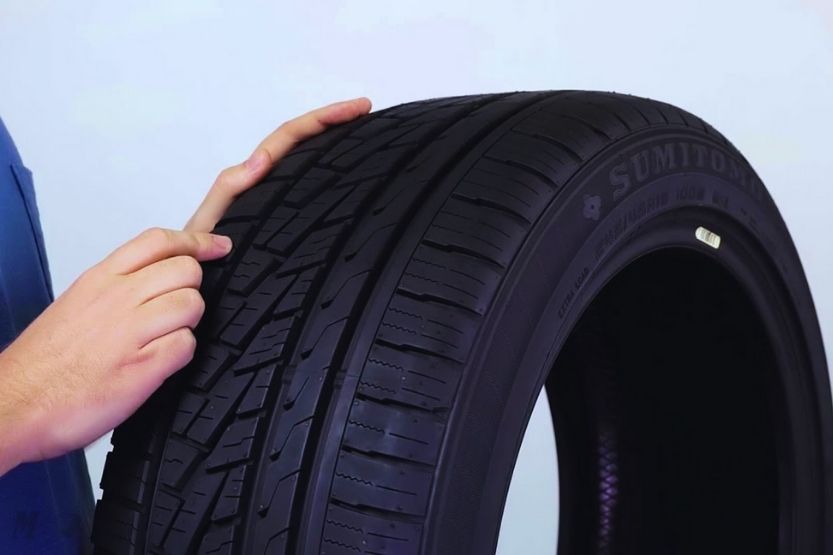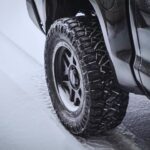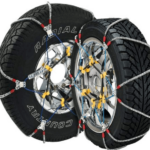Rough winter weather generates some of the most dangerous and challenging driving conditions possible. It’s dangerous to drive in the snow or on ice. Knowing about snow tires is important because of the reduced visibility and slick roads. But what are snow tires?
Snow tires, also known as winter tires, are meant to be used on snow and ice. Snow tires have a tread pattern with greater gaps than regular tires, which improves traction on snow and ice.
Read on to learn more about snow tires, their features, and how they differ from all-season tires.
What Are Snow Tires?

Composition of Snow Tires
Snow tires are made of rubber compositions that include sand, such as volcanic ash or silicate, that improve traction on the road. As a result, the rubber between the cuts improves traction in poor or extreme driving situations.
Contain More Tread Cuts
Snow tires contain more tread cuts, aiding traction in various road situations. They have sipes, little slices in the tire that grip the road as much as they can under wet, slippery, black ice, and snowy situations.
They have grooves or channels around the tire’s circumference that removes sleet and snow while driving.
Narrower Than Summer Tires
The width of snow tires is usually narrower than that of summer tires. Tires with narrow treads have less touch with the road. Switching from the back of the car’s wider tires to something that takes up less space provides a benefit.
Factors to Consider When Choosing the Snow Tires’ Size
Before buying snow tires, ensure they’re the correct diameter and tread width for your vehicle. Factory-size tire and wheel sizing have developed throughout the years, with today’s 16″, 17″, 18″, and larger sizes replacing yesterday’s conventional 13″, 14″, and 15″ sizes.
Broad, low-profile tires fitted on big wheels are standard equipment or factory options on many current automobiles, vans, and light trucks.
Below are some factors you should consider when determining the size of snow tires:
- Vehicle’s factory-size tire and wheel size
- The tire and wheel size from your vehicle’s base model
- A minus-size tire and wheel
3 Main Features of Snow Tires
Under snowy and slippery conditions, snow tires outperform all-season tires. They provide superior traction, turn stability, and stopping power. All-season tires don’t perform as well in snow as in snow tires.
Snow tires are designed specifically for traction in snowy and icy conditions. This is not the case with other tires. Snow tires are distinguished from regular and all-season tires by three primary characteristics:
- Rubber composition,
- Tread depth and pattern, and
- Biting edges.
1. Rubber Composition
Snow tires are manufactured with softer rubber compounds and additional silica to increase flexibility and ice traction. Hence, they perform better in snow, ice, slush, mud, and dry pavement.
Most manufacturers now utilize silica-based rubber compounds; some even add traction pieces and hollow “cells” to the recipe to squeeze and suction water off the road.
2. Tread Depth and Pattern
The unique tread also helps to extract more water from the ice. Deeper tread depths improve traction and reduce snow buildup. Also, winter tires have distinct tread patterns or grooves. By efficiently pushing water through the tread, these unique grooves help to prevent hydroplaning.
Moisture is pushed out of the tire and away from the ground, allowing your wheel to establish solid contact with dry ground. The tread’s “micro pump” holes act as plungers, sucking water from the road and spitting it out as the tire rolls.
3. Sipes
Winter tires contain more sipes (cuts in the tread) than all-season tires to wipe more water off the road. Sawtooth sipes have a larger surface area and are better at cutting through snow and slush than straight sipes.
FAQs – What Are Snow Tires?

How Long Do Snow Tires Last?
Snow tires have a longer lifespan than regular tires, although they need additional maintenance. As soon as the first snowflakes fall, put your snow tires on and take them off when spring arrives.
Winter tires can survive three or four winters if you remove them and inspect the tread for wear after each winter.
How Do You Maintain Winter Tires?
1. Routine Maintenance
By doing routine maintenance, you may extend the life of your winter tires.
2. Maintain Proper Air Pressure
Maintaining proper air pressure is essential for keeping your tires in good shape and avoiding tread wear. Tire air pressure drops in cold weather; therefore, you should check it regularly. Do not over-inflate your tires since this can put an additional load on them.
3. Regular Tire Rotations and Alignments
Tire rotations and alignments should also be done regularly. Because winter tires and “normal” tires don’t mix, don’t utilize two snow tires. Both types will wear out faster and become less effective if you do.
4. Store in a Clean and Dry Location
Keep your winter tires in a clean, dry location during the summer. They should not be near grease or oil, nor should they be in a hot environment. Your garage should be okay, but you should cover them with waterproof covers to keep them safe.
Though tires are pretty massive and occupy a lot of room, they last longer if stored correctly. Many experts recommend keeping your tires because the softer rubber will quickly wear out in the summer.
How Much Does A Set of Snow Tire Cost?
Price Varies Depending on Brand
The price of snow tires varies by brand, but without discounts, car snow tires should cost around $150, and SUV/truck snow tires should cost about $200.
A complete set of tires for a car costs $600; a spare costs $750. For SUVs and trucks, a complete set will set you back at least $800, with the spare set costing an additional $1,000.
Tire Manufacturers Offer Discount
Remember, too, that many tire manufacturers run discounts on their goods, and depending on the deal, you can earn mail-in rebates or even a nearly-free tire.
Some folks choose to purchase an additional set of rims for their winter tires. Prices vary greatly depending on the maker, but $65 is average. It costs $260 for a complete set and $325 for a spare.
Less Expensive Snow Tires Can Do Well on a Slick Winter Road
Tires can be costly, but you should be able to acquire good-quality snow tires for a reasonable price. Less expensive snow tires can do just as well on a slick winter road.
The tread will not last as long, the tire will be composed of a slightly weaker material, and they are unlikely to be suitable for large trucks. On the other hand, cheaper snow tires can be a valuable weapon in the struggle against winter when driving a car or SUV.
Do You Need Snow Tires?
According to experts, people living in locations with winters that have temperatures of 40 degrees or lower for weeks should consider snow tires.
People who travel to cold locations for hobbies or vacations should also consider snow tires. If you enjoy skiing or cold-weather travels to Minnesota, you should install these tires.
You could be put off by the cost and hassle of owning two sets of tires. While the initial price of snow tires is high, rotating sets of tires might save you money in the long term. Each set of tires will last longer, and driving with the proper tires reduces your chances of getting involved in an accident.
When Do I Need New Snow Tires?
The traction of snow tires is dependent on the deep tread. Even when they’ve lost most of their usefulness, they may still look nice to the naked eye. They’re not gripping the snow well until they reach 6/32-inch tread depth.
You must recycle them since they are 5/32-inch, even if they appear new. You defeat the entire purpose of winter tires if you use them for too long.
Again, what are snow tires, and do you need them? Snow or winter tires are equipped with tread patterns with gaps greater than regular tires. So it improves traction during the snow, so best to use it during this condition.
It is not recommended that you keep the winter tires on your vehicle for the entire year since they wear out faster than all-season tires in warm or dry conditions.
Best Snow Tires for Your Car

Just because a tire is labeled a “snow tire,” it does not automatically imply that it will be a good fit for your vehicle. Look for thread kinds and features that are appropriate for your setting.
We have listed seven snow tires that you can choose from in this article:
1. Sumitomo Ice Edge Snow Radial Tire
Sumitomo’s Ice Edge Snow Radial Tires are cost-effective and perform remarkably well in ice and snow-covered driving conditions. The treads have serrations that aid and optimize bite. These tires can be studded, giving those who require them even more winter driving control.
2. Bridgestone Blizzak Winter/Snow Passenger Tire
Although all authorized snow tires are designed to be used in sub-zero weather, some perform better than others when the temperature drops to dangerously low levels. In this regard, the Bridgestone Blizzak WS80 tires are among the best.
They stay softer and supple in extreme cold than other brands because they are made with specially developed hydrophilic rubber. This can make the difference between keeping on track and losing control of your car in the winter.
3. Cooper Evolution Winter Tire
The Cooper Tire Evolution Winter Tire’s extra-aggressive tread design makes it a must-have for the harshest winter conditions, especially in snow-covered places for much of the year.
4. Nokian Nordman 7 Studded Winter Tire
The Nokian Nordman 7 Studded Winter Tires are ideal for people who drive a lot in the winter and need the finest traction possible on hard-packed snow and ice.
Even when driving on the slickest snowy surfaces, the pre-installed metal studs boost tread aggression, making a loss of control considerably less likely.
5. Cooper Discoverer M+S Winter Radial Tire
Ideal for SUVs and Light Vehicles
The Discoverer M+S Winter Radial Tires are ideal for SUVs and light vehicles that travel on icy roads frequently.
Has Aggressive and Wear-resistant Treads
The aggressive and wear-resistant treads and deeper-than-average zigzag ribbing help bigger passenger vehicles to have the maximum possible grip on cold, slick surfaces.
The core sawtooth pattern helps stabilize each wheel and evenly distribute wear, resulting in better driving control for as long as possible.
6. Michelin X-ICE Tire
The Michelin X-ICE X13 Tire can effectively withstand wear, according to patented technology that claims to adjust the rubber’s consistency based on temperature. According to the manufacturer, these snow tires help steady the car during travel.
7. Pirelli Scorpion Winter Tire
The Pirelli Scorpion Winter is designed to fit modern SUVs and CUVs, focusing on the high-end category, and contributes significantly to driver safety by ensuring optimal stability and control in snow, wet, and dry situations.
These tires were made with more silica rubber than other versions to boost traction.
Conclusion – What Are Snow Tires?
Snow tires, also known as winter tires, are designed to keep your car stable, whether driving in ice, snow, or freezing temperatures. The deep tread and tire edges hold the road and prevent snow accumulation, which can cause slipping and loss of control.
Unlike all-season tires, snow tires’ rubber tread functions well in freezing weather because it remains flexible. On winter roads, these snow tires dramatically prevent slipping. Winter tires outperform all-season tires on ice.
The right tires can improve the safety and performance of your vehicle. Some all-season tires are advertised as suitable for summer and winter driving. This may be true in dry, warm areas with little seasonal variation.
On snow and ice, you would need a snow tire for solid traction, braking, and control. You will also need snow tires if you live in an environment that experiences cold weather and snow. A good set of snow tires will help you stay safe and relaxed behind the wheel.
Read next:



![Best All-Season Tire for Snow [Top 10 Tires] best all season tire for snow](https://roadsumo.com/wp-content/uploads/2022/10/best-all-season-tire-for-snow-150x150.jpg)

![GeoTour Tires Review [Who Makes Them? Are They Good?] geotour tires](https://roadsumo.com/wp-content/uploads/2021/05/geotour-tires-150x150.jpg)

![Read more about the article How to Flatten a Tire Quickly and Safely [Legal]](https://roadsumo.com/wp-content/uploads/2022/05/how-to-flatten-a-tire-quickly-and-safely-300x200.jpg)

